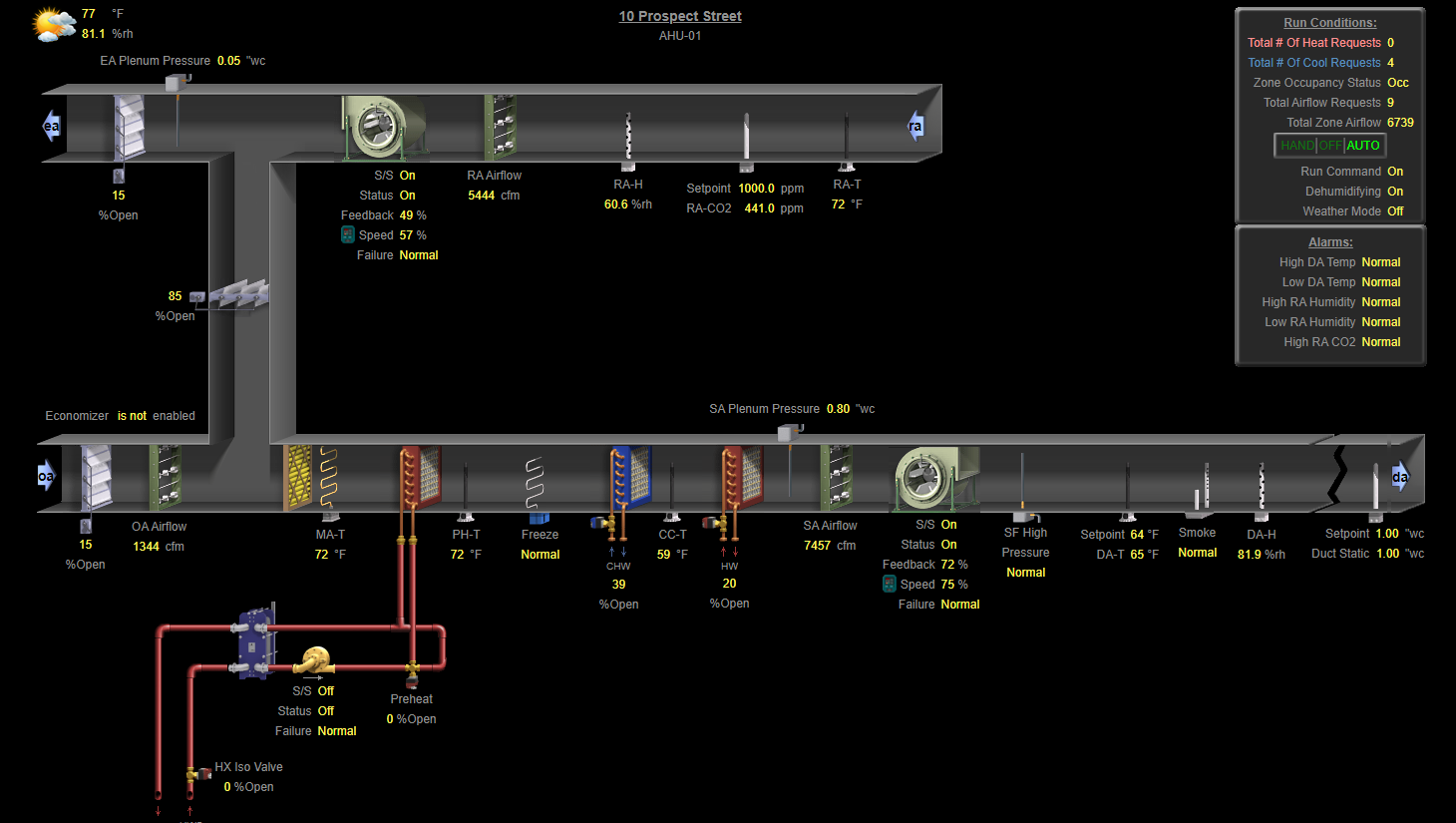Since the beginning of the modern HVAC industry, the design, installation and testing of a building automation system (BAS) has remained relatively untouched. The process is as follows: First, an engineer will develop control drawings and desired sequence of operations for the various pieces of HVAC equipment in their design documents. From there, an Automated Temperature Controls (ATC) contractor will review the design documents and install the BAS accordingly. At the end, the system will be commissioned and finally turned over to the Owner. However, throughout that process there are changes made to the system and the final product is a transformed (and typically improved) version of what the design once was.
With a well-functioning design and construction team, the process can be smooth and effortless. However, without engaged team members many important details regarding the design and implementation of the BAS control system may slip through the cracks. Sometimes it may be the fault of a design engineer who is too pressed for time or is unfamiliar with the complexity of newer building automation systems. Other times it is due to an ATC contractor who is not accustomed to the level of complexity in the project, or who disregards the design requirements in favor of canned routines (see our previously written article, Canned Routines: The Good, The Bad and The Ugly). Lastly, it may be that the BAS was either poorly commissioned or never commissioned at all, resulting in setpoints, schedules and sequences not reflective of the actual building and Owner’s requirements.
After every project I’ve commissioned, I find myself reflecting on the entire process and wondering what could have been done better. Whether it was a design issue that caused a re-programming of the sequence of operations, or an ATC contractor who failed to meet the design requirements, there are always speedbumps during the tail end of projects. Even if it is a retro-commissioning investigation conducted on an existing building, I find myself wondering, “how did the building automation system drift so far from design? What could have been done to prevent this?” What can we as an industry do to prevent these shortcomings from occurring and ensure the Owner has the best building automation system and control sequences to meets their needs? The answer seems to lie within the newly published ASHRAE Guideline 36 “High Performance Sequence of Operation for HVAC Systems”.
Due to common issues like those I outlined above, The American Society of Heating, Refrigerating and Air-Conditioning Engineers (ASHRAE) formed a committee and began analyzing what they could do to mitigate these problems. Together, they constructed a guideline that provides uniform sequences of operations for HVAC systems with a focus on energy efficiency, performance, control stability and real-time fault detection. In the summer of 2018, ASHRAE approved Guideline 36 “High Performance Sequence of Operation for HVAC Systems”, the end result of this committee’s hard work. This guideline contains an immense amount of detailed information on designing, constructing and commissioning an HVAC controls system based on today’s technology and the industry’s best practices.
The guideline is set up in an organized manner that guides the reader through the controls design process of various HVAC systems. Throughout the guideline, there is a generous number of notes that describe to the reader exactly what is needed to achieve the control strategies, why they are necessary, and recommendations dependent on the intended design. Depending on the HVAC systems being designed, the guideline first goes into detail describing the required BAS hardwired points, point naming nomenclature, alarms and other applicable parameters. Next, high-performance sequences of operations are descriptively written out, including how the actual programming should be set up by the ATC contractor. The sequences described in the guideline represent some of the most efficient control algorithms in the industry, including trim and response resets, PID loop tuning and advanced demand control ventilation.
One of the most important aspects of Guideline 36 is the inclusion of Automated Fault Detection and Diagnostics (AFDD). Simply put, AFDD is a sophisticated set of rules and alarms that will continuously detect and diagnose system faults as they occur and alert the operator before systemic issues and complaints occur. Like the check engine light in your car, these alarms will not only provide a description of the fault detected, but a diagnosis as well.
Let’s look at a failed chilled water valve on an air handling unit as an example of how AFDD can be utilized. Imagine a chilled water control valve serving an air handling unit fails open and is unable to close. In the past, this would result in a lower supply air temperature. Downstream, variable-air-volume boxes will notice the low supply air temperature when spaces cool and open their heating valves to reheat the air and maintain space temperature at setpoint. No alarms. No complaints. Without an observant operator, this fault may go undetected for months and cost the building owner thousands of dollars in utility bills. With AFDD, this fault can be quickly identified and addressed. An AFDD alarm specific to this example could monitor the chilled water valve command, the mixed air temperature and supply air temperature. When the condition occurs, the BAS would flag that the control valve is commanded closed, but the supply air temperature remains lower than the mixed air temperature. The AFDD would notify the operator with a descriptive narrative of the fault and a list of possible diagnostics which would include investigating the chilled water valve operation. What would once remain a hidden and costly issue for months can now be identified within minutes.
ASHRAE Guideline 36 “High Performance Sequences of Operation for HVAC Systems” will always be a work in progress, and is intended to be continuously updated as new technologies and systems are developed. While this publication is only a guideline and not yet required for code compliance, the possibilities of how this guideline may be used are endless. Building certification committees and campus standards may soon start realizing the benefits of a standardized building automation system and requiring that the guideline be followed. This new guideline can also aid design engineers who understand the importance of a well-developed HVAC control system but are unable to fully vet and review their design due to tight project schedules. With Guideline 36, an engineer can confidently specify that the ATC contractor must meet the guideline’s requirements and know that the system will be installed and commissioned following the best industry standards. As Guideline 36 began because of questions, the procurement of it also raises more. Will ATC contractors need some sort of ASHRAE Guideline 36 credential to prove they can meet the guideline requirements? Will AFDD be required in projects moving forward regardless of Guideline 36? What are the long-term cost benefits of implementing these high-performance sequences of operations versus not? These are questions that should be asked, and I encourage everyone to think deeply about what’s in store the future of HVAC controls.
Contact us with any questions regarding ASHRAE Guideline 36 or click here to learn more about our services.
Reference:
ASHRAE, ASHRAE Guideline 36-2021. High Performance Sequence of Operation for HVAC Systems. 2021, American Society of Heating, Refrigerating, and Air-Conditioning Engineers, Inc.: Atlanta, GA.

About the Author:
Brian Messerschmidt is a Project Manager at Sustainable Engineering Solutions. He has managed numerous Commissioning and Retro-Commissioning projects throughout Connecticut and Massachusetts. Brian earned his B.S. in Mechanical Engineering from Central Connecticut State University. He is a registered Professional Engineer in the State of Connecticut and a Certified Energy Manager through the Association of Energy Engineers.

